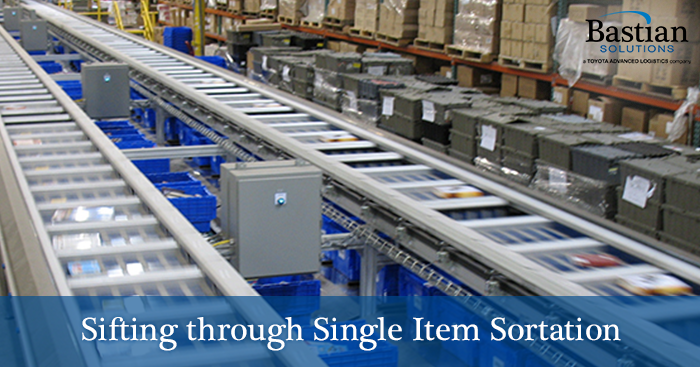
Sifting Through Single Item Sortation
Evan Cleveland | 01 October 2019
Single item sortation was created to automatically sort small single items into multiline order containers and single line, single item orders. They are ideal for sorting many like products (single SKU) to multiple active orders awaiting fulfillment, as well as alternatively for manufacturing and reverse logistics. Methods of single item sortation include tilt-tray, push tray, cross belt and OPEX Sure Sort.
How It Works
For most applications, the methodology behind using a single item sorter is to distribute like products (a single SKU) to multiple active orders awaiting fulfillment. The first step is picking an inventory bin from bulk storage or batch picking the required number of units for the active orders. From there the container will travel to any induction location on the sorter where an operator will induct each item individually onto the sorter. Each unit will travel along the sorter's path and be dispensed to a location (typically a chute) to the active order's container. Active order containers can consist of shipping boxes, large gaylords, auto-bagging machines, etc.
Once completed/filled, the active order container can be processed and sent to shipping. It is common for operators to apply an LPN (license plate number) barcode so the container can route to the shipping/manifesting department of the facility, however, this can also be pre-applied onto the shipping container.
Operation Flow Chart
Sortation Diagram
Benefits:
- Excellent for order profiles that have SKU commonality
- Efficient picking (batch picking, bulk inventory bins) & high throughput
- High number of sortation destinations
- Any product can be presented to any induction location along the sorter
- Can be used to fill orders with numerous shipping containers
- Can be easily combined with automation (upstream and downstream)
Drawbacks:
- Operators are needed at active order locations/chutes to process completed/filled containers
- Can take up a lot of space
- Not modular once integrated/installed
- Needs conveyance to effectively transport material to and from sorter
Requirements/Qualifications:
- WMS
- Interface/Sortation Software
- Conveyance (supply and takeaway inventory and order containers)
- Floor Space
Evan is a Field Application Engineer with Bastian Solutions Texas. He obtained a Bachelor of Science degree in Mechanical Engineering from Texas Tech University. Since starting in 2015, he has helped start the Dallas office and has sold, managed, & integrated numerous projects ranging from $25,000 to $6-million for clients in Texas and surrounding states.
Comments
No comments have been posted to this Blog Post
Leave a Reply
Your email address will not be published.
Comment
Thank you for your comment.